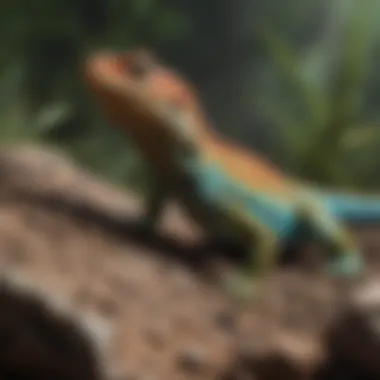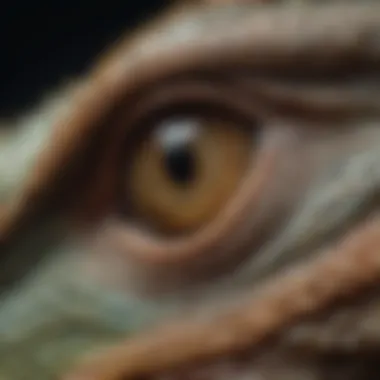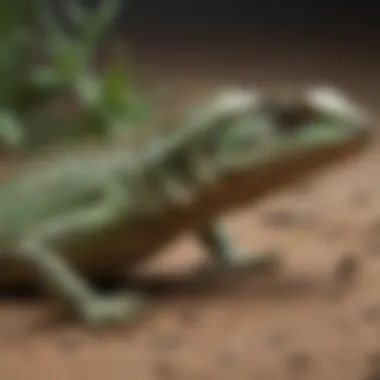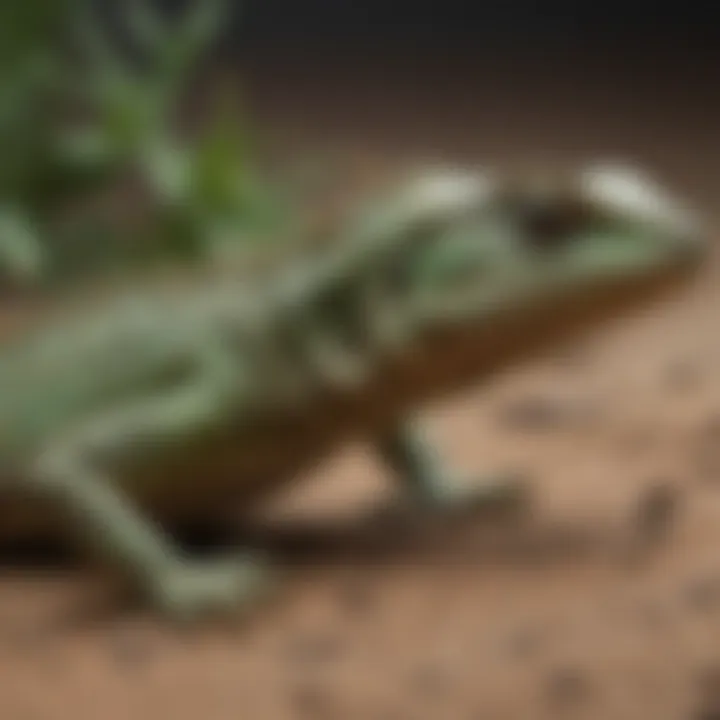Exploring the Endangerment of Lizards: An Overview


Intro
Lizards are fascinating creatures, with diverse species and adaptable traits. However, many of these reptilian species face various threats, leading to a significant decline in their populations. To understand the endangerment of lizards, it is crucial to examine the factors contributing to their decline, relevant conservation efforts, and their role in ecosystems. This article aims to present a thorough insight into the plight of lizards and emphasize the necessity for immediate action.
Overview of Research Topic
Brief Background and Context
The world of lizards is vast, comprising over 6,000 species. Each species plays a unique role in its environment, from controlling insect populations to serving as prey for larger animals. However, habitat destruction, climate change, and invasive species are putting many populations at risk. According to the International Union for Conservation of Nature (IUCN), a growing number of lizard species are classified as threatened. These trends underscore a pressing concern for biodiversity and ecological health.
Importance in Current Scientific Landscape
Understanding the decline of lizard populations holds significance beyond mere numbers. Lizards are indicative of ecosystem conditions, acting as bioindicators. Their health reflects the overall state of environments. As such, studying their endangerment can provie insights into broader ecological changes and help in formulating effective conservation strategies. Scientists and conservationists must prioritize research on lizards to address this growing concern.
Methodology
Research Design and Approach
This article utilizes a comprehensive literature review approach. It includes peer-reviewed articles, reports from conservation organizations, and data from ecological studies. The aim is to provide a holistic view of lizard endangerment by reviewing existing knowledge and identifying gaps for future research.
Data Collection Techniques
Data have been collected from various reputable sources, including databases such as IUCN Red List and national biodiversity inventories. By aggregating this data, a clearer picture emerges of the factors affecting lizard populations. Moreover, this synthesis allows for identifying key conservation efforts and their effectiveness in addressing the crisis.
"A comprehensive understanding of lizard conservation needs empowers stakeholders to implement more effective strategies and ensure these reptiles' survival."
The exploration of these elements offers a foundation for understanding the complex dynamics of lizard endangerment. Addressing these concerns not only helps save lizards but also aids in preserving the rich biodiversity of our planet.
Prolusion to Lizard Conservation
Lizard conservation encompasses many important factors regarding the survival of these reptiles. The need to understand the role of lizards in ecosystems is vital. They fulfill many ecological roles, which if disrupted, can lead to severe consequences on biodiversity.
Lizards contribute to the balance of nature. They help control insect populations, thus maintaining the hierarchy of food chains. The extinction of a lizard species may trigger detrimental shifts in ecological balance, causing other species to flourish unchecked. Henceforth, recognizing the importance of lizards in ecosystems forms the backbone of conservation discussions.
Importance of Lizards in Ecosystems
The Role of Lizards in Food Chains
Lizards frequently occupy a central role in various food chains, functioning as both predators and prey. They feed on insects, arachnids, and other small creatures, regulating their populations. In return, many larger predators, like birds and mammals, depend on lizards as a vital food source. Thus, their presence is an essential component in preserving the delicate equilibrium. The key characteristic here is their dual role which supports the overall health of ecosystems. These interactions contribute to the biological diversity we see today.
However, lizard populations face various threats that may impact this role. If certain species decline, the ripple effect could result in increased insect populations, which may lead to crop damage and other economic implications. Therefore, understanding lizards’ role in food chains is a huge benefit to this work.
Lizards as Indicators of Ecosystem Health
Lizards can indicate the health of their environment effectively. As ectotherms, their physiological processes respond directly to changes in temperature and habitat conditions. This means they can serve as barometers for ecological shifts. For instance, a sudden decline in lizard populations can signal habitat degradation, making them a valuable indicator species. The unique feature of this characteristic is the direct correlate to environmental conditions, making lizards a popular choice for research in conservation.
The advantages of using lizards in this context include the ability to monitor changes swiftly. If their numbers drop, it usually calls for immediate conservation measures. Though there are disadvantages, such as the complexities of species-specific requirements and adaptability, the utility of lizards as indicators underscores their ecological importance.
Overview of Lizard Biodiversity
Global Distribution of Lizards
Lizards display a vast global distribution across various continents and habitats. From tropical rainforests to arid deserts, their adaptability highlights their evolutionary success. This wide-ranging distribution is beneficial in this work as it shows lizards' resilience and their ability to colonize diverse ecological niches. It illustrates how interconnected global ecosystems are and demonstrates the importance of preserving these unique habitats.
However, the geographic variability also presents challenges. Habitat loss due to urbanization and climate change tends to impact certain regions more than others, leading to localized extinctions. The understanding of global distribution paves the way for targeted conservation efforts in regions most in need.
Variety of Lizard Species
The variety among lizard species is striking, with thousands of species identified worldwide. This diversity is crucial for maintaining ecological resilience. For example, some species can thrive in specific environments while others might adapt in completely different ones. This diversity brings balance and stability to ecosystems. The key aspect of this variety is its contribution to genetic resilience, ensuring that ecosystems can withstand changes.
Yet, with diversity comes complexity. The unique features of lizard species can lead to difficulties in conservation efforts, especially when addressing the needs of specific species. Understanding the various adaptations helps highlight both the advantages and disadvantages of species conservation efforts. It emphasizes the need for in-depth research tailored toward specific lizard ecological roles.
Factors Contributing to Lizard Endangerment
Understanding the factors that contribute to the endangerment of lizards is crucial for conservation strategies. Lizards play essential roles in ecosystems, and their decline can indicate broader environmental issues. Effective conservation efforts must address these factors to ensure the health of lizard populations and their habitats.
Habitat Destruction
Urbanization and Land Use Change
Urbanization leads to significant habitat loss for lizards. As cities expand, natural habitats are converted into urban landscapes. This change reduces the availability of food, shelter, and breeding grounds for lizards. Additionally, urban areas often have increased pollution and disturbances that further impact their survival. Urbanization can also create barriers, isolating lizard populations and reducing genetic diversity.


Deforestation and Its Impact
Deforestation is a direct threat to lizard habitats, particularly in tropical regions. The removal of trees and vegetation causes habitat fragmentation and destruction. This affects lizard populations as they rely on specific environments for their survival. Increased logging and agriculture disrupt these habitats and lead to a decline in lizard species. The loss of biodiversity due to deforestation is a pressing concern that needs immediate attention.
Climate Change Impacts
Temperature Extremes
Temperature extremes brought on by climate change are a significant threat to lizard species. Many lizards are ectothermic, meaning their body temperature is regulated by their environment. Extreme heat can lead to physiological stress and increased mortality rates. It limits their range and affects their ability to reproduce. Understanding the tolerance levels of different lizard species to temperature change is vital for their conservation.
Altered Habitat Conditions
Climate change can alter habitat conditions, such as moisture levels and vegetation types. These changes affect food availability and shelter for lizards. Altered habitats may also increase the risk of disease, impacting lizard populations. Furthermore, the shift in climate can lead to mismatches in food sources and predator-prey relationships, putting additional pressure on lizard populations.
Invasive Species Threats
Competitive Interactions
Invasive species can severely impact native lizard populations through competition. Non-native species may compete for food, habitat, and resources, undermining the survival of local lizards. For example, invasive predatory species can outcompete lizards for prey, leading to declines in their populations. The successful control of invasive species is essential to protect the native lizard populations and maintain their ecological niches.
Predation by Non-Native Species
Invasive predators can directly threaten lizards by increasing predation pressure. Species such as feral cats and rats have been shown to prey on various lizard species. Their introduction into new ecosystems often leads to dramatic declines in native lizard populations. Addressing the threats posed by these predators is critical for preserving the remaining lizard communities.
Overexploitation
Illegal Pet Trade
The illegal pet trade significantly contributes to the decline of certain lizard species. Often, collectors remove lizards from their natural habitats without regard for their population sustainability. This demand can lead to local extinctions and adversely impacts ecosystems where these species play a role. While some species cope with captive breeding, many do not survive transit or adaptation to captivity.
Medicinal and Cultural Uses
Some lizard species are exploited for medicinal or cultural use in various societies. This demand can lead to excessive harvesting, further endangering wild populations. The economic incentives for using these species often overlook the potential long-term consequences on their populations. Sustainable practices should be considered to balance the cultural significance with conservation needs.
Methods for Assessing Lizard Populations
Understanding the methods used for assessing lizard populations is crucial in the larger context of lizard conservation. These methods provide insights into population size, distribution, and overall health. By employing various techniques, researchers can gather data that informs conservation strategies and gauge the success of existing efforts. Accurate assessment allows for timely intervention when populations decline, ensuring effective conservation measures are in place.
Field Surveys and Monitoring Techniques
Field surveys are fundamental for collecting direct observations of lizard populations in their natural habitats. These monitoring techniques help scientists understand the local demographic trends and behavioral patterns of lizards.
Visual Encounter Surveys
Visual Encounter Surveys, or VES, involve researchers actively searching for lizards in predefined areas. This method is straightforward and requires minimal equipment, making it accessible. The key characteristic of VES is that it relies on visual detection of lizards, providing immediate data on their abundance in an area. As a beneficial choice, VES allows for rapid assessments within short timeframes.
One unique feature of VES is its ability to estimate not only abundance but also patterns of distribution. The primary advantage is its effectiveness in various habitats where lizards are easily observable. However, it also has limitations. For instance, it may overlook cryptic species that remain hidden from sight.
Radio Telemetry
Radio Telemetry is another valuable tool for studying lizard movements and behavior. This method involves attaching small radio transmitters to lizards, allowing researchers to track their locations over time. The key characteristic of radio telemetry is its capacity for long-term tracking, providing insights into individual movement patterns and habitat use. This method is popular for studying species with large home ranges and those that are difficult to capture repeatedly.
The unique feature of this technique is the ability to monitor lizard behavior in real-time. One advantage is that it enables researchers to assess the impact of environmental changes on lizard populations. Nevertheless, challenges do exist, such as potential stress on the animals caused by the transmitters and the logistical difficulties of tracking them in dense habitats.
Genetic Analyses for Population Assessment
Genetic analyses is increasingly recognized as a powerful approach in lizard population studies. These methods can unveil important information about genetic diversity and population structure, which are critical for effective conservation planning.
DNA Barcoding
DNA Barcoding is a method that uses a short genetic sequence from a standardized region of an organism's DNA. This technique helps in identifying species and can reveal cryptic diversity in what might appear to be a single species. The key characteristic of DNA Barcoding is its precision and reliability in species identification. It is a beneficial choice because it can rapidly assess biodiversity in a given area.
A unique feature of this method is its ability to detect species that are hard to distinguish morphologically. The advantage of DNA Barcoding lies in its high accuracy and its application across different life stages of lizards. However, limitations include the need for adequate genetic databases for comparison and potential issues with sample degradation.
Population Genetic Studies
Population Genetic Studies focus on the genetic variability among lizard populations. These studies provide insights into gene flow, population structure, and genetic diversity. The key characteristic of these studies is their ability to assess both historical and contemporary population dynamics. They offer a beneficial perspective on how genetic factors influence population viability.
One unique feature of population genetic studies is their potential to inform on the evolutionary dynamics of lizards under various environmental pressures. The advantage of these studies is the detailed understanding they bring into population health and resilience. Nonetheless, they require extensive sampling and can be time-consuming, with interpretations that necessitate expertise in genetics and statistics.
In summary, methods for assessing lizard populations combine field surveys and genetic analyses to create a comprehensive picture of their status. These methods are not only essential for the health of lizard populations but are also integral to conserving their ecological roles in diverse habitats.


Conservation Efforts for Lizards
The conservation of lizards is essential for maintaining biodiversity and ecosystem balance. As various species face the threat of endangerment, targeted actions are needed to protect these reptiles. Conservation efforts can help reverse population declines and protect their habitats, ensuring that they continue to play their critical roles in ecosystems. This section discusses several approaches that have been employed in lizard conservation, including the establishment of protected areas, captive breeding programs, and community involvement.
Protected Areas and Reserves
Establishing Conservation Areas
Establishing conservation areas is one of the most effective strategies for protecting lizard populations. These areas are designed to preserve habitats that are crucial for various lizard species, allowing them to thrive with minimal human interference. A key characteristic of these areas is their legal protection, which restricts activities that could harm native wildlife. By creating safe havens, we can ensure that lizard populations have the necessary space and resources to reproduce and flourish.
However, the success of these conservation areas can depend on their size and connectivity. Larger reserves that are connected to other natural habitats tend to be more beneficial. They allow for genetic diversity and enable lizards to migrate in response to environmental changes.
Management of Protected Habitats
Management of protected habitats involves active efforts to maintain the ecological integrity of conservation areas. This includes habitat restoration, control of invasive species, and ecological monitoring. A key benefit of effective management is that it directly enhances the survival rate of lizard species. Properly managed habitats can provide the appropriate microclimates and resources lizards need.
A unique feature of managing protected areas is the participation of local communities. Engaging them in conservation efforts can create a sense of stewardship and responsibility. However, the challenges might include conflicts over land use, which require careful negotiation and collaboration.
Captive Breeding and Reintroduction Programs
Success Stories in Lizard Conservation
Captive breeding and reintroduction programs have shown promising results in several lizard conservation cases. These programs aim to breed lizards in controlled settings and later release them into their natural habitats. A notable success story includes the recovery of the Brachymeles bicolor, a species once considered critically endangered. By providing a supportive breeding environment and releasing healthy individuals into suitable habitats, this kind of program can significantly increase population numbers.
These programs are beneficial as they can recover species whose populations have drastically declined due to habitat loss or other threats. However, they require significant funding, resources, and expertise to ensure success.
Challenges in Reintroduction Efforts
The challenges in reintroduction efforts can be substantial. One major issue is the acclimatization of bred lizards to wild conditions. Often, lizards raised in captivity do not have the necessary survival skills. Furthermore, establishing viable populations requires suitable habitats and addressing threats like predation.
Reintroduction efforts can be complex and often require multiple attempts before a stable population is established. Continuous monitoring and support are crucial for overcoming these challenges and ensuring the long-term success of the program.
Community Involvement and Education
Engaging Local Communities in Conservation
Engaging local communities in conservation efforts is critical. When local populations are involved, there is a larger chance of success. Communities can become active participants in protecting lizard habitats, sharing valuable indigenous knowledge and practices. A significant characteristic of this approach is its emphasis on empowerment and collaboration.
Moreover, local involvement can lead to sustainable conservation practices tailored to specific ecosystems. However, challenges may arise when community interests conflict with conservation goals, necessitating careful dialogue.
Educational Programs and Awareness Campaigns
Educational programs and awareness campaigns play an important role in lizard conservation. They aim to inform the public about lizard species, their ecological importance, and the threats they face. A key benefit of these initiatives is that they foster a sense of responsibility among community members, encouraging them to participate in conservation efforts.
Unique features of educational campaigns include hands-on activities, school programs, and community workshops, all designed to inspire action. The challenge often lies in ensuring consistent access to resources and materials for these programs. Success depends largely on sustained community interest and participation.
The Role of Scientific Research in Conservation
Scientific research plays a vital role in understanding the complex issues surrounding lizard endangerment. It provides foundational knowledge that informs conservation strategies, helping us to identify priorities and allocate resources more effectively. Researchers explore various facets concerning lizards, from their behavior to their genetics and habitats. This knowledge can then be applied to develop targeted conservation efforts and interventions, ultimately aiming to stabilize or increase lizard populations.
Evidence-based practices are crucial. Without rigorous scientific inquiry, efforts to conserve at-risk species may be misguided or ineffective. For lizards, research can highlight critical areas for protection and identify which species are most vulnerable. Additionally, studies provide insight into adaptive responses to environmental changes, which is essential for crafting effective management plans.
Emerging Research Areas
Behavioral Ecology of Lizards
Behavioral ecology focuses on lizard behaviors and their ecological contexts. Understanding how lizards interact with their environment and other species is essential for conservation. It reveals effective strategies for habitat utilization and mating, which can influence population resilience. Surveys of behavioral changes in response to habitat disturbance can offer insights into which lizard species can adapt to new conditions.
The emphasis on behavioral ecology is beneficial in this article as it sheds light on how changes in ecosystems impact lizard survival. One particular characteristic is the study of territorial behaviors and their implications for population density. This understanding helps conservationists in habitat design, ensuring that essential behaviors are supported in managed areas. However, behavioral studies can skew due to small sample sizes, leading to potentially misleading conclusions about population dynamics.
Biodiversity Analysis and Modeling
Biodiversity analysis involves assessing the variety of lizard species and their genetic diversity. Comprehensive modeling approaches aim to forecast population trends and identify conservation hotspots. This method is crucial for evaluating how various factors, including climate change, habitat loss, and invasive species, affect lizard populations.
This analytic approach is significant for this article as it informs decision-makers about the critical areas of focus for conservation. By modeling the impacts of various threats, stakeholders can prioritize interventions. One unique feature is the incorporation of predictive modeling, which can anticipate future biodiversity outcomes under different scenarios. However, limitations arise from reliance on current data, which may not accurately represent future conditions.
Collaborative Research Initiatives
International Conservation Programs
International conservation programs unite efforts from different countries to address global species conservation. They promote sharing of knowledge, resources, and strategies across borders. Such collaborations can amplify the impact of conservation efforts, particularly when dealing with migratory lizard species or preserving shared habitats.


This collaborative approach is particularly valuable in this article. International programs provide a coordinated response to conservation challenges. They encourage the pooling of scientific resources to tackle pressing threats to lizards. A unique feature is that these programs often lead to policy development which enhances protective measures for species at risk. Challenges can arise in coordinating efforts and ensuring consistent implementation across different legal and cultural contexts.
Partnerships with Academic Institutions
Partnerships between conservation organizations and academic institutions facilitate advanced research and innovation. These collaborations harness academic expertise and resources while focusing on practical conservation outcomes. By involving students and researchers in ongoing projects, such partnerships help to grow the next generation of conservation scientists.
Such collaborations are beneficial for this article as they bridge the gap between theory and practice. These academic affiliations promote the use of cutting-edge techniques in lizard conservation, such as genetic analysis and habitat modeling. Additionally, collaboration expands funding opportunities which can help sustain long-term research. However, dependency on academic schedules may slow down project timelines, meaning immediate responses to crises may be delayed.
"Scientific research is essential for informed conservation decisions. Without understanding lizard behaviors and biodiversity, effective strategies cannot be formulated."
This segment outlines critical areas of scientific inquiry that can improve conservation outcomes. By emphasizing emerging research and collaborative initiatives, we highlight the multifaceted approaches necessary to address the challenges faced by lizards today.
Future Directions in Lizard Conservation
The future of lizard conservation hinges on innovative strategies and adaptive management practices. It is imperative to explore emerging technologies and robust legislation to safeguard these reptiles. Transitioning towards a forward-thinking approach will significantly enhance the effectiveness of conservation efforts.
Innovative Technologies in Monitoring
Remote Sensing Techniques
Remote sensing has emerged as a revolutionary tool in ecological studies. This technique allows researchers to gather data from satellite images, aerial photography, and other remote platforms. It provides a broad perspective on habitat conditions without the need for invasive field studies. One key characteristic of remote sensing is its ability to cover vast areas quickly. This feature makes it particularly beneficial in lizard conservation. Researchers can monitor changes over time in landscape features that impact lizard populations.
Advantages of remote sensing include reduced costs and improved efficiency in habitat assessment. However, it may lack the specific detail required for localized studies. The integration of remote sensing data with field observations can yield a more comprehensive view of lizard populations and their habitats.
Use of Artificial Intelligence
Artificial intelligence (AI) offers promising advancements in data analysis and population monitoring. By utilizing machine learning algorithms, researchers can process large datasets to identify trends and anomalies within lizard populations. A key aspect of AI is its capacity to improve prediction models. These models can forecast population dynamics in response to environmental changes. This makes AI a favored tool in contemporary conservation strategies.
One unique feature of AI is its ability to continuously learn from new data. This aspect ensures that conservation efforts evolve based on the latest findings. However, reliance on AI also poses challenges, such as the need for high-quality data and the potential for algorithmic biases. Nonetheless, its advantages in predictive analysis hold great promise for lizard conservation.
Policy and Legislation for Protection
Environmental Legislation and Enforcement
The role of environmental legislation is critical in protecting lizard populations. Effective laws and regulations help mitigate threats stemming from habitat destruction and climate change. Environmental legislation ensures that ecosystems where lizards thrive are maintained. One significant characteristic of this legislation is its ability to enforce conservation actions legally.
Legislation can also be beneficial as it provides accountability for actions that harm lizard habitats. Yet, enforcement can often be a challenge, particularly in areas where resources are limited. Raising awareness and fostering community support are essential for successful enforcement of these laws.
The Role of International Treaties
International treaties play a crucial role in encompassing lizard conservation on a global scale. Treaties such as the Convention on International Trade in Endangered Species (CITES) aim to ensure that international trade does not threaten lizard populations. The key characteristic of these treaties is their focus on collaboration among nations.
These agreements fosters coordinated efforts in research, monitoring, and policy implementation. However, challenges remain related to compliance and varying national priorities. Enhancing the effectiveness of treaties demands steady international cooperation and a commitment to shared objectives to protect lizard species.
End and Call to Action
The conclusion serves as a critical component in clarifying the significance of lizard conservation. It encapsulates the essential findings of the article, reinforces the imperatives of action, and outlines what must be done moving forward. The continuous decline of lizard populations is alarming and indicative of wider ecological issues. Comprehensive understanding and strategic responses are necessary to alleviate causes of decline.
Lizards play an innate role in the ecosystem. Their decline directly impacts food webs and biodiversity. Acknowledging this interconnectedness is essential for effective conservation strategies. As highlighted in earlier sections, habitat destruction, climate change, and invasive species pose significant threats.
This article aims to bridge the gap between awareness and action. The call to action urges individuals, communities, and policymakers to engage in lizard conservation efforts actively. Here are some specific considerations related to the call to action:
- Increasing awareness about the ecological importance of lizards
- Supporting habitat restoration projects
- Advocating for stronger legislation and enforcement against illegal wildlife trade
- Participating in community-based conservation programs
In summary, the fate of lizards is a reflection of our stewardship of the environment. Sustainable practices can ensure their survival and promote biodiversity.
Summary of Key Findings
The exploration of lizard endangerment reveals several significant points:
- Lizards are vital in maintaining ecological balance.
- Factors affecting their survival include habitat loss, climate change, invasive species, and overexploitation.
- Conservation efforts encompass habitat protection, captive breeding, and community education.
- Scientific research remains essential in informing and advancing conservation strategies.
These findings emphasize the urgent need for comprehensive action and enhanced research to facilitate conservation efforts.
Encouragement for Continued Research and Conservation
Continuing research in lizard ecology and conservation is vital for several reasons. Firstly, it contributes to a deeper understanding of lizard behavior and population dynamics. Such knowledge is essential for formulating effective conservation policies.
Furthermore, research informs conservation efforts by providing data that guides habitat management and restoration. Engaging interdisciplinary approaches can yield robust strategies to combat the multifaceted threats to lizards.
Collaboration between scientists, NGOs, policymaking bodies, and local communities can enhance conservation outcomes. An environment where research informs practice is critical.
Conservationists must also focus on securing ongoing funding for research and field projects. This can establish a sustainable model that prioritizes biodiversity and ecosystem health. Ultimately, every effort counts in reversing the trends of lizard endangerment.
"The survival of lizards is intertwined with our ecological practices; our actions can ensure diversity or accelerate decline."
Encouraging participation from various stakeholders can empower communities, paving the way for effective conservation actions. It is essential to maintain momentum in research and education efforts, ultimately bolstering the long-term survival of these remarkable reptiles.



